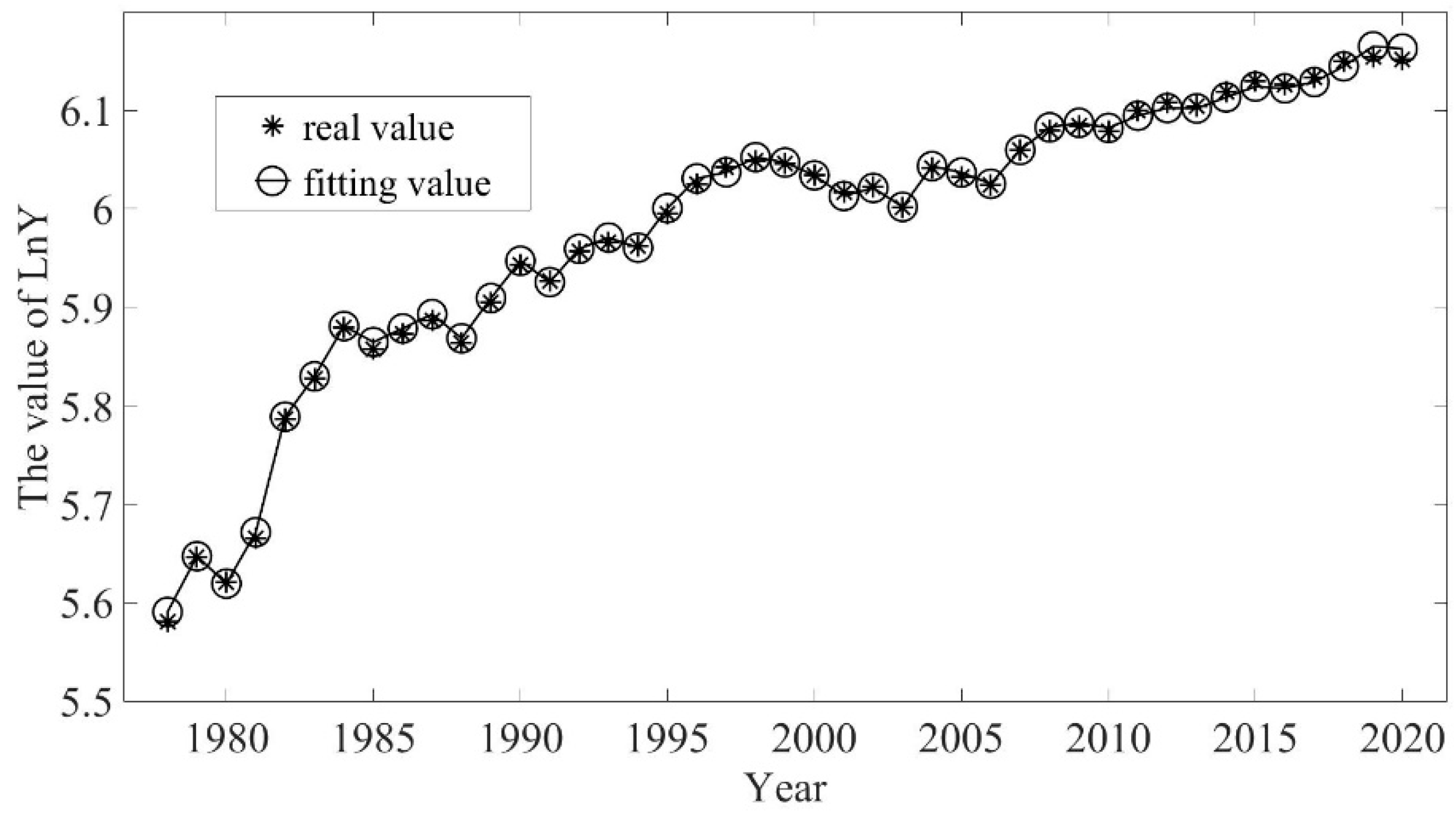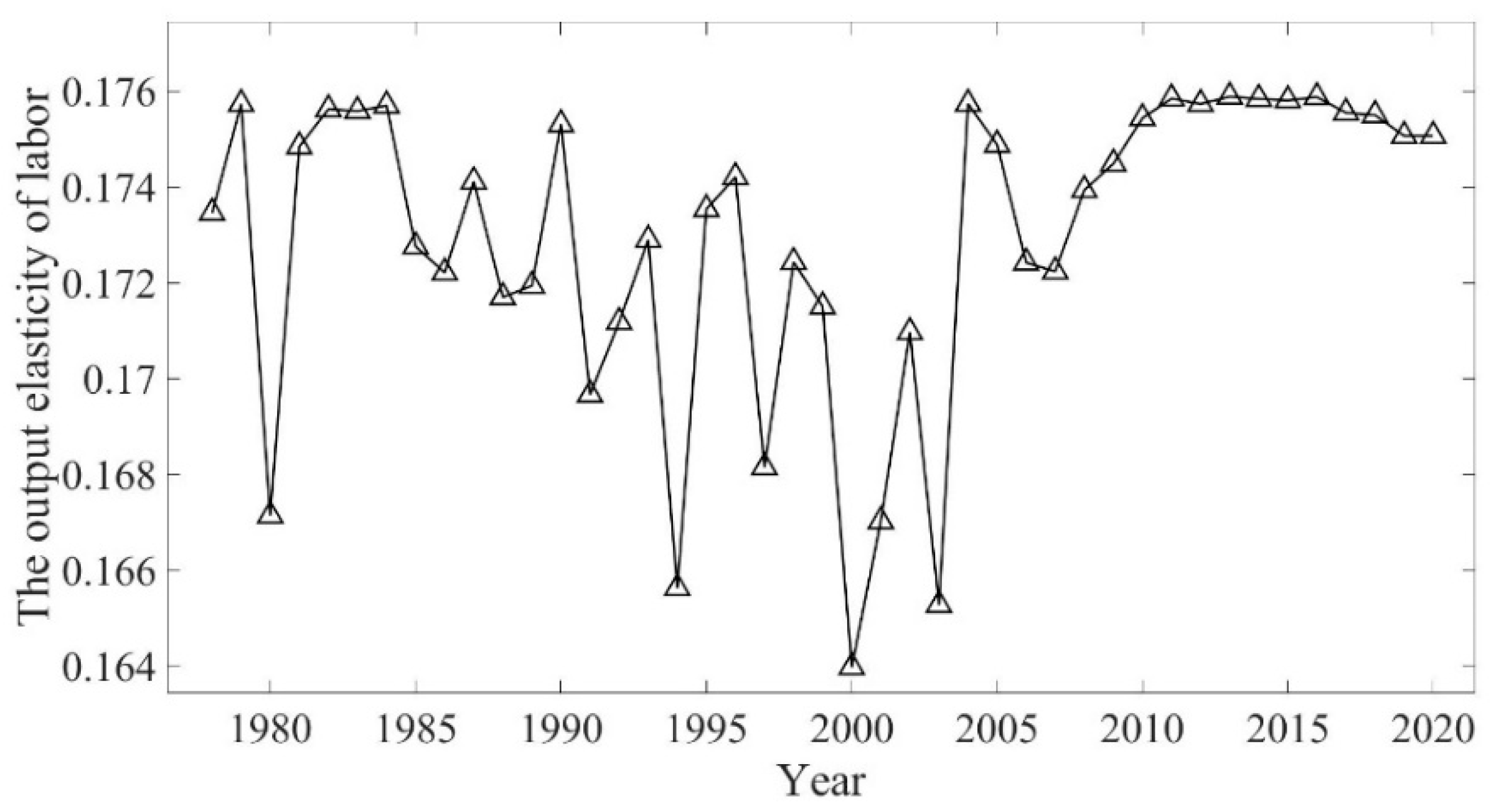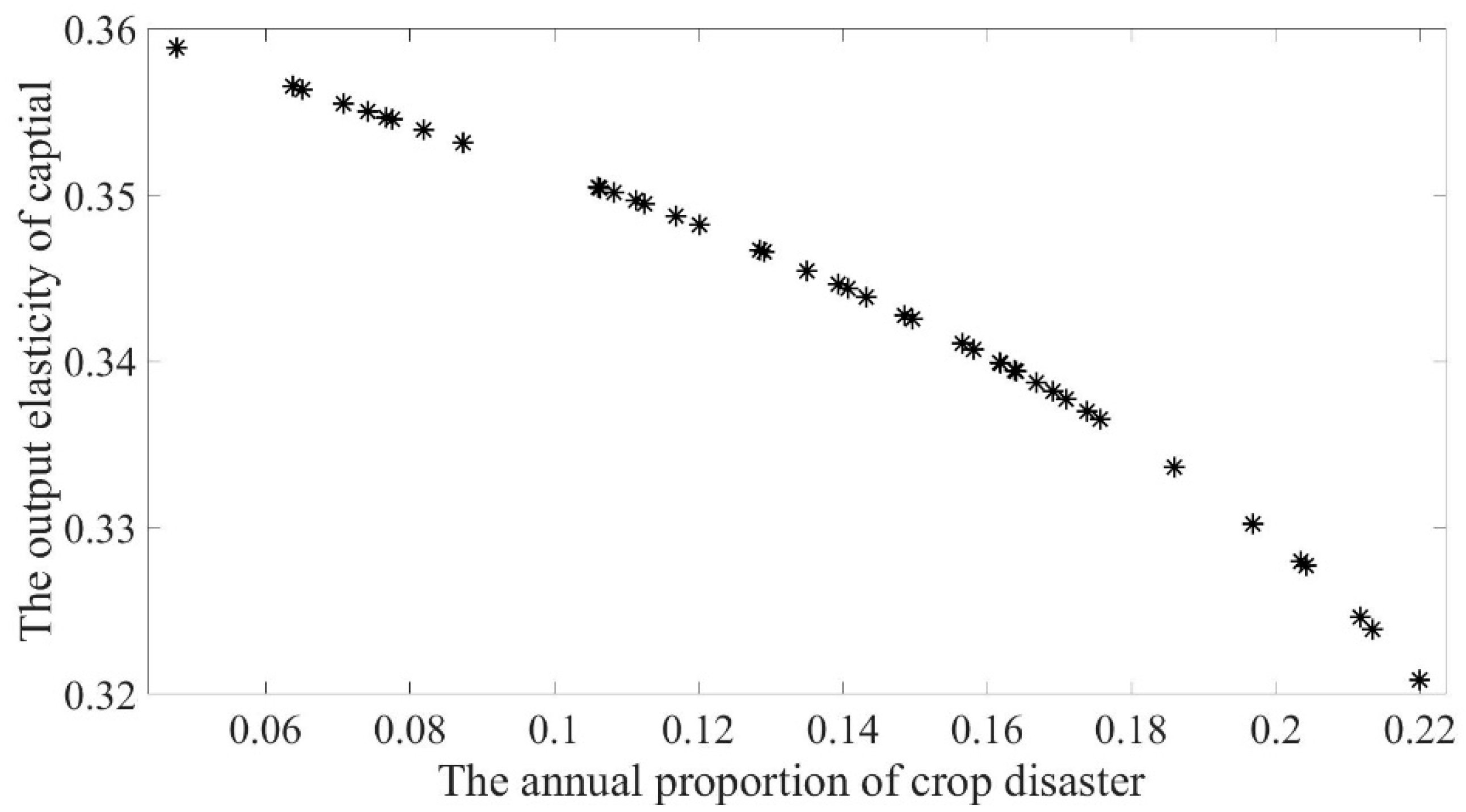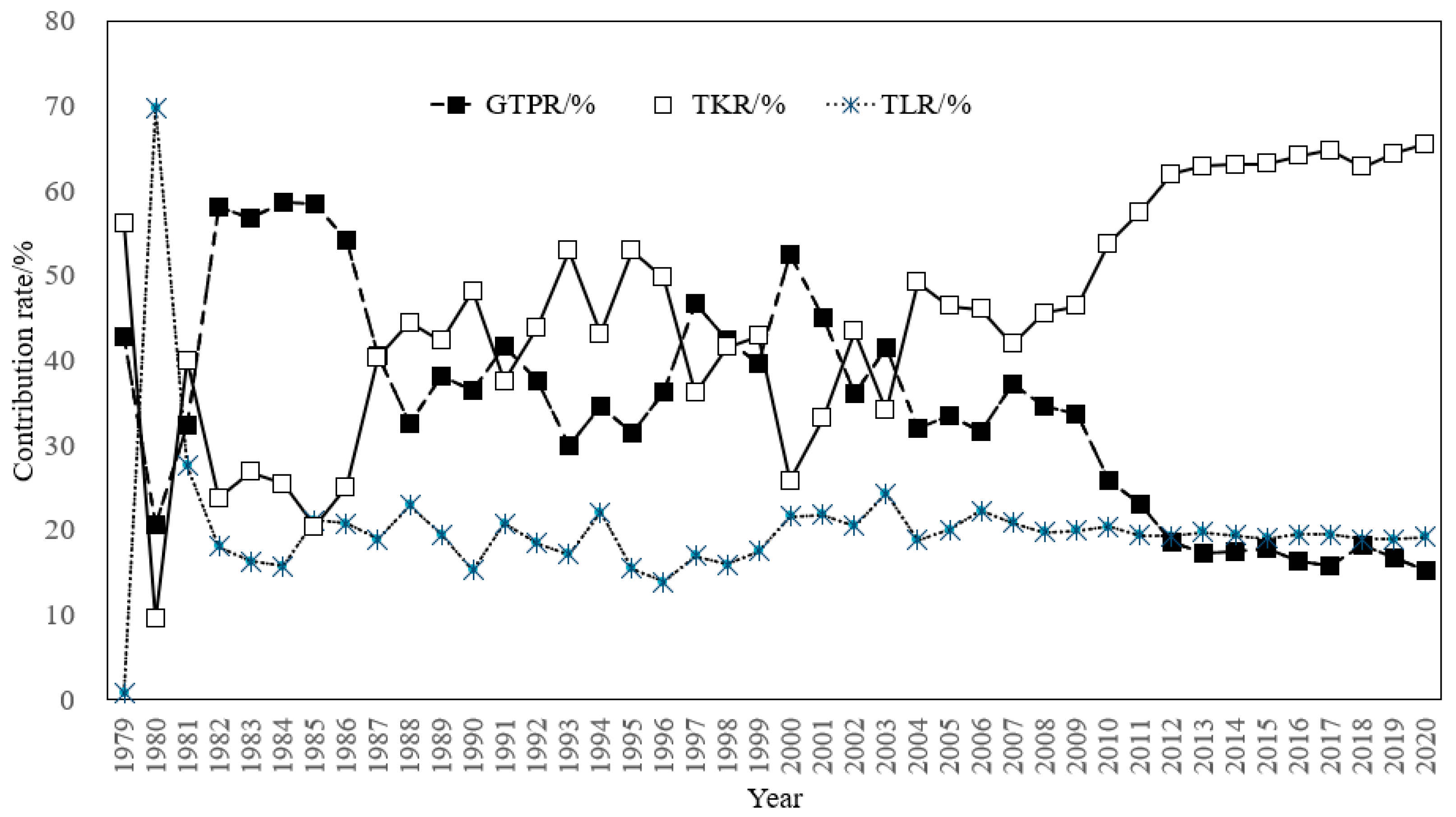Measurement and Analysis of Contribution Rate for China Rice Input Factors via a Varying-Coefficient Production Function Model
Abstract
:1. Introduction
2. Materials and Methods
2.1. Proposed Model
- (1)
- Natural disasters are an important factor that affect the technical efficiency of rice production. Therefore, they are also a covariant factor that affects the changes of rice capital elasticity and labor elasticity. A natural disaster is represented by the annual proportion of crop disaster Z. It is assumed that the output elasticity is a smooth function dependent on the proportion of crop disaster.
- (2)
- Generally, the technical level, A, is neutral, which essentially reflects the impact of all other factors except for capital and labor inputs on output growth. Therefore, it is assumed that the technical level, A, does not depend on the change due to natural disasters, but only on the change of time, reflecting its dynamic characteristics.
- (3)
- Supposing the natural disaster factor and the time factor are independent. Such an assumption suggests that the occurrence of natural disasters is completely random.
2.2. Estimation Method
2.3. Bandwidth Selection
- 1)
- ;
- 2)
- and is a constant.
2.4. Measurement Methods on Contribution Rate of Input Factors
3. Empirical Analysis and Results
3.1. Data Source
3.2. Results of Estimation
3.3. Contribution Rate of Rice Input Factors
3.4. Decomposition of Capital Contribution Rate
4. Discussion
4.1. Policy Implications
4.2. Advantage of the Proposed Model and Applications in Future Work
5. Conclusions
- (1)
- From 1978 to 2020, the value of capital elasticity of rice yield growth in China is between 0.3209 and 0.3589, with mean 0.3437, and the value of labor elasticity is between −0.1759 to −0.1640 with mean −0.1730, indicating capital elasticity and labor elasticity are not constant in different years.
- (2)
- The correlation coefficient between capital elasticity and the annual proportion of crop disasters is −0.9817, and correlation coefficient between labor elasticity (absolute value) and the annual proportion of crop disasters is −0.8752, presenting a negative relationship for both. With an increase in the annual proportion of crop disasters, the decreasing speed of capital elasticity and labor elasticity tends to increase. When the annual proportion of crop disasters is more than about 18%, the capital elasticity and the labor elasticity show a significant decline curve, proving that natural disasters have a great impact on capital elasticity and labor elasticity. Therefore, we should focus on the long-term strengthening of disaster prevention and resistance. In view of the possibility of the more frequent occurrence of extreme weather events, we should systematically consider various links such as variety cultivation, water conservancy projects, farmland construction, agricultural machinery and agronomy, explore scientific methods, and promote the improvement of the agricultural disaster prevention and relief work system and mechanism.
- (3)
- Compared with 1978, the GTPR of China’s rice yield growth from 1979 to 2020 shows a declining trend in fluctuations, whereas the TKR shows a rising trend in fluctuations and the TLR is relatively stable in the same period. The value of GTPR is between 15.30% and 58.71%, the TKR is between 9.57% and 65.52%, and the TLR is between 0.92% and 69.373%. Since 2000, the increase in rice yield per unit area in China mainly depended on the increase of capital investment. The top four input factors are machinery, chemical fertilizer, seed and pesticide in the order of contribution rate. To ensure the sustainable and healthy development of China’s rice industry, it is suggested to reasonably limit the use of chemical fertilizers and pesticides, vigorously develop agricultural mechanization technology, and strengthen rice variety cultivation.
Author Contributions
Funding
Institutional Review Board Statement
Informed Consent Statement
Data Availability Statement
Conflicts of Interest
Appendix A
| Year | α | β |
|---|---|---|
| 1978 | 0.3426 | −0.1735 |
| 1979 | 0.3504 | −0.1757 |
| 1980 | 0.3280 | −0.1671 |
| 1981 | 0.3466 | −0.1748 |
| 1982 | 0.3497 | −0.1756 |
| 1983 | 0.3495 | −0.1756 |
| 1984 | 0.3502 | −0.1757 |
| 1985 | 0.3408 | −0.1728 |
| 1986 | 0.3394 | −0.1722 |
| 1987 | 0.3444 | −0.1741 |
| 1988 | 0.3382 | −0.1717 |
| 1989 | 0.3388 | −0.1719 |
| 1990 | 0.3482 | −0.1753 |
| 1991 | 0.3337 | −0.1697 |
| 1992 | 0.3370 | −0.1712 |
| 1993 | 0.3411 | −0.1729 |
| 1994 | 0.3246 | −0.1656 |
| 1995 | 0.3428 | −0.1735 |
| 1996 | 0.3446 | −0.1742 |
| 1997 | 0.3302 | −0.1681 |
| 1998 | 0.3399 | −0.1724 |
| 1999 | 0.3378 | −0.1715 |
| 2000 | 0.3209 | −0.1640 |
| 2001 | 0.3277 | −0.1670 |
| 2002 | 0.3366 | −0.1710 |
| 2003 | 0.3239 | −0.1653 |
| 2004 | 0.3505 | −0.1757 |
| 2005 | 0.3467 | −0.1749 |
| 2006 | 0.3399 | −0.1724 |
| 2007 | 0.3395 | −0.1722 |
| 2008 | 0.3439 | −0.1739 |
| 2009 | 0.3455 | −0.1745 |
| 2010 | 0.3488 | −0.1754 |
| 2011 | 0.3546 | −0.1758 |
| 2012 | 0.3555 | −0.1757 |
| 2013 | 0.3532 | −0.1759 |
| 2014 | 0.3547 | −0.1758 |
| 2015 | 0.3550 | −0.1758 |
| 2016 | 0.3539 | −0.1759 |
| 2017 | 0.3564 | −0.1755 |
| 2018 | 0.3566 | −0.1755 |
| 2019 | 0.3589 | −0.1751 |
| 2020 | 0.3589 | −0.1751 |
| Year | GTPR/% | NKR/% | KDR/% | TKR/% | NLR/% | LDR/% | TLR/% |
|---|---|---|---|---|---|---|---|
| 1979 | 42.89 | 15.06 | 41.13 | 56.19 | 12.77 | −11.85 | 0.92 |
| 1980 | 20.70 | 40.82 | −31.25 | 9.57 | 40.75 | 28.98 | 69.73 |
| 1981 | 32.38 | 23.85 | 16.15 | 40.00 | 32.93 | −5.31 | 27.63 |
| 1982 | 58.08 | 12.68 | 11.11 | 23.79 | 21.20 | −3.07 | 18.13 |
| 1983 | 56.77 | 17.92 | 8.97 | 26.89 | 18.78 | −2.44 | 16.34 |
| 1984 | 58.71 | 17.51 | 7.98 | 25.49 | 17.82 | −2.01 | 15.80 |
| 1985 | 58.43 | 22.51 | −2.11 | 20.41 | 20.49 | 0.68 | 21.17 |
| 1986 | 54.11 | 28.58 | −3.51 | 25.07 | 19.68 | 1.13 | 20.82 |
| 1987 | 40.66 | 38.44 | 1.93 | 40.37 | 19.53 | −0.56 | 18.98 |
| 1988 | 32.66 | 49.63 | −5.20 | 44.43 | 21.27 | 1.64 | 22.91 |
| 1989 | 38.26 | 46.19 | −3.92 | 42.28 | 18.25 | 1.21 | 19.46 |
| 1990 | 36.56 | 43.08 | 5.07 | 48.14 | 16.58 | −1.28 | 15.30 |
| 1991 | 41.67 | 46.05 | −8.52 | 37.53 | 18.05 | 2.75 | 20.80 |
| 1992 | 37.61 | 48.73 | −4.87 | 43.87 | 17.04 | 1.48 | 18.52 |
| 1993 | 29.94 | 54.21 | −1.28 | 52.94 | 16.77 | 0.36 | 17.13 |
| 1994 | 34.72 | 58.95 | −15.80 | 43.15 | 17.20 | 4.93 | 22.13 |
| 1995 | 31.55 | 52.79 | 0.17 | 52.96 | 15.54 | −0.05 | 15.49 |
| 1996 | 36.37 | 48.23 | 1.50 | 49.73 | 14.29 | −0.39 | 13.89 |
| 1997 | 46.79 | 44.78 | −8.58 | 36.20 | 14.40 | 2.61 | 17.01 |
| 1998 | 42.51 | 43.33 | −1.79 | 41.54 | 15.48 | 0.48 | 15.96 |
| 1999 | 39.60 | 46.19 | −3.33 | 42.86 | 16.63 | 0.90 | 17.53 |
| 2000 | 52.58 | 41.04 | −15.24 | 25.80 | 17.19 | 4.43 | 21.62 |
| 2001 | 45.03 | 44.16 | −10.99 | 33.17 | 18.68 | 3.12 | 21.81 |
| 2002 | 36.06 | 47.88 | −4.43 | 43.45 | 19.32 | 1.16 | 20.49 |
| 2003 | 41.53 | 48.63 | −14.52 | 34.11 | 20.33 | 4.03 | 24.36 |
| 2004 | 31.96 | 43.75 | 5.46 | 49.21 | 19.79 | −0.96 | 18.83 |
| 2005 | 33.58 | 43.48 | 2.92 | 46.40 | 20.63 | −0.61 | 20.02 |
| 2006 | 31.67 | 47.98 | −1.95 | 46.03 | 21.86 | 0.44 | 22.30 |
| 2007 | 37.20 | 43.97 | −2.06 | 41.90 | 20.44 | 0.45 | 20.89 |
| 2008 | 34.68 | 44.71 | 0.82 | 45.53 | 19.95 | −0.16 | 19.79 |
| 2009 | 33.64 | 44.58 | 1.82 | 46.40 | 20.30 | −0.33 | 19.96 |
| 2010 | 25.87 | 49.77 | 3.98 | 53.74 | 21.02 | −0.63 | 20.39 |
| 2011 | 23.07 | 50.14 | 7.36 | 57.50 | 20.14 | −0.71 | 19.43 |
| 2012 | 18.68 | 54.07 | 7.88 | 61.96 | 20.01 | −0.65 | 19.36 |
| 2013 | 17.32 | 56.38 | 6.53 | 62.91 | 20.44 | −0.68 | 19.76 |
| 2014 | 17.52 | 55.82 | 7.23 | 63.05 | 20.06 | −0.62 | 19.43 |
| 2015 | 17.80 | 55.86 | 7.27 | 63.13 | 19.65 | −0.59 | 19.06 |
| 2016 | 16.32 | 57.43 | 6.71 | 64.15 | 20.12 | −0.59 | 19.53 |
| 2017 | 15.74 | 56.80 | 8.00 | 64.80 | 19.95 | −0.48 | 19.47 |
| 2018 | 18.21 | 55.02 | 7.83 | 62.84 | 19.38 | −0.44 | 18.94 |
| 2019 | 16.76 | 55.30 | 9.04 | 64.34 | 19.25 | −0.34 | 18.91 |
| 2020 | 15.30 | 56.42 | 9.10 | 65.52 | 19.51 | −0.33 | 19.18 |
| Year | Seed Cost/% | Chemical Fertilizer Cost/% | Farm Fertilizer Cost/% | Pesticide Cost/% | Agricultural Film Cost/% | Mechanical Operation Cost /% | Irrigation and Drainage Cost/% | Animal Power Cost/% | Fuel Power Cost/% | Other Cost/% |
|---|---|---|---|---|---|---|---|---|---|---|
| 2000 | 1.98 | 7.38 | 0.91 | 1.93 | 0.36 | 2.76 | 2.33 | 2.38 | 0.01 | 5.77 |
| 2001 | 2.26 | 9.39 | 1.17 | 2.60 | 0.43 | 3.64 | 3.21 | 2.99 | 0.00 | 7.47 |
| 2002 | 3.20 | 12.00 | 1.45 | 3.26 | 0.54 | 4.90 | 3.88 | 3.51 | 0.01 | 10.70 |
| 2003 | 2.48 | 9.65 | 1.00 | 2.87 | 0.38 | 4.04 | 3.16 | 2.73 | 0.08 | 7.71 |
| 2004 | 3.62 | 15.83 | 1.79 | 4.83 | 0.66 | 7.11 | 3.99 | 3.86 | 0.21 | 7.29 |
| 2005 | 3.89 | 16.29 | 1.57 | 5.03 | 0.70 | 7.95 | 3.51 | 3.26 | 0.10 | 4.10 |
| 2006 | 3.93 | 15.18 | 1.36 | 6.06 | 0.67 | 9.28 | 3.57 | 2.99 | 0.12 | 2.88 |
| 2007 | 3.52 | 13.59 | 0.99 | 5.67 | 0.59 | 9.40 | 3.03 | 2.75 | 0.07 | 2.30 |
| 2008 | 3.50 | 16.54 | 1.06 | 5.65 | 0.56 | 10.91 | 2.62 | 2.56 | 0.08 | 2.04 |
| 2009 | 4.10 | 15.04 | 1.10 | 5.66 | 0.49 | 12.19 | 2.81 | 2.36 | 0.32 | 2.34 |
| 2010 | 5.42 | 15.88 | 1.34 | 6.47 | 0.58 | 15.72 | 2.97 | 2.25 | 0.22 | 2.89 |
| 2011 | 5.97 | 17.44 | 1.11 | 6.25 | 0.58 | 17.56 | 3.15 | 2.09 | 0.33 | 3.01 |
| 2012 | 6.60 | 18.25 | 1.15 | 6.69 | 0.60 | 20.10 | 3.04 | 1.85 | 0.34 | 3.33 |
| 2013 | 6.92 | 17.56 | 1.10 | 6.63 | 0.59 | 21.46 | 3.20 | 1.44 | 0.39 | 3.60 |
| 2014 | 7.28 | 16.22 | 1.04 | 6.74 | 0.60 | 22.89 | 2.77 | 1.36 | 0.44 | 3.72 |
| 2015 | 7.30 | 16.07 | 1.13 | 6.75 | 0.59 | 23.17 | 2.73 | 1.18 | 0.45 | 3.77 |
| 2016 | 7.61 | 15.88 | 1.13 | 6.79 | 0.62 | 23.93 | 2.74 | 0.99 | 0.51 | 3.95 |
| 2017 | 7.96 | 16.04 | 1.16 | 6.90 | 0.59 | 24.03 | 2.64 | 0.75 | 0.65 | 4.07 |
| 2018 | 7.74 | 15.99 | 1.17 | 6.54 | 0.54 | 23.30 | 2.53 | 0.53 | 0.57 | 3.93 |
| 2019 | 7.88 | 16.61 | 1.14 | 6.86 | 0.51 | 23.73 | 2.74 | 0.41 | 0.65 | 3.81 |
| 2020 | 8.18 | 16.47 | 1.17 | 7.35 | 0.51 | 24.24 | 2.60 | 0.32 | 0.72 | 3.97 |
References
- Mohidem, N.A.; Hashim, N.; Shamsudin, R.; Che Man, H. Rice for food security: Revisiting its production, diversity, rice milling process and nutrient content. Agriculture 2022, 12, 741. [Google Scholar] [CrossRef]
- FAOSTAT. Production/Yield Quantities of Rice, Paddy in World + (Total) 1978–2020. Food and Agriculture Organization of the United Nations. 2022. Available online: https://www.fao.org/faostat/en/#data/QCL/visualize (accessed on 2 September 2022).
- Huang, M.; Shan, S.L.; Xie, X.B.; Cao, F.B.; Zou, Y.B. Why high grain yield can be achieved in single seedling machine-transplanted hybrid rice under dense planting conditions? J. Integr. Agric. 2018, 17, 1299–1306. [Google Scholar] [CrossRef]
- Zhang, X.F.; Wang, D.Y.; Fang, F.P.; Zhen, Y.K.; Liao, X.Y. Food safety and rice production in China. Res. Agric. Mod. 2005, 26, 85–88. [Google Scholar]
- Ma, G.H.; Yuan, L.P. Hybrid rice achievements, development and prospect in China. J. Integr. Agric. 2015, 14, 197–205. [Google Scholar] [CrossRef]
- Li, J.J.; Li, J.P. International comparison of rice production cost and benefit and China’s development prospects. China Rice 2021, 27, 22–30. [Google Scholar]
- Huang, M.; Tang, Q.Y.; Ao, H.J.; Zou, Y.B. Yield potential and stability in super hybrid rice and its production strategies. J. Integr. Agric. 2017, 16, 1009–1017. [Google Scholar] [CrossRef]
- Xu, L.; Yuan, S.; Man, J.G. Changes in rice yield and yield stability in China during the past six decades. J. Sci. Food Agric. 2020, 100, 3560–3569. [Google Scholar] [CrossRef] [PubMed]
- Li, Z.H.; Ma, X.; Chen, L.T.; Li, H.W.; Huang, Y.Q.; Li, J.R.; Luo, G.W.; Yao, J.H. Effects of coupling of nursing seedling densities and seedling fetching area on transplanting quality and yield of hybrid rice. Trans. Chin. Soc. Agric. Eng. (Trans. CSAE) 2019, 35, 20–30. [Google Scholar]
- Espe, M.B.; Hill, J.E.; Leinfelder-Miles, M.; Espino, L.A.; Mutters, R.; Mackill, D.; Kessel, C.V.; Linquist, B.A. Rice yield improvements through plant breeding are offset by inherent yield declines over time. Field Crops Res. 2018, 222, 59–65. [Google Scholar] [CrossRef]
- Umetsu, C.; Lekprichakul, T.; Chakravorty, U. Efficiency and technical change in the Philippine rice sector: A Malmquist total factor productivity analysis. Am. J. Agric. Econ. 2003, 85, 943–963. [Google Scholar] [CrossRef]
- Elahi, E.; Cui, W.J.; Zhang, H.M.; Nazeer, M. Agricultural intensification and damages to human health in relation to agrochemicals: Application of artificial intelligence. Land Use Policy 2019, 83, 461–474. [Google Scholar] [CrossRef]
- Liu, S.W.; Zhang, P.Y.; He, X.L.; Wang, Z.Y.; Tan, J.T. Productivity and efficiency change in China’s grain production during the new farm subsidies years: Evidence from the rice production. Custos E Agronegocio 2015, 11, 106–123. [Google Scholar]
- Mariano, M.J.; Villano, R.; Fleming, E. Are irrigated farming ecosystems more productive than rainfed farming systems in rice production in the Pilippines? Agric. Ecosyst. Environ. 2010, 139, 603–610. [Google Scholar] [CrossRef]
- Mariyono, J. Decomposition total factor productivity of Indonesian rice production. Econ. J. Emerg. Mark. 2018, 10, 121–127. [Google Scholar] [CrossRef]
- Wang, J.Q.; Song, H.H.; Tian, Z.W.; Bei, J.L.; Zhang, H.Y.; Ye, B.; Ni, J. A method for estimating output elasticity of input factors in Cobb-Douglas production function and measuring agricultural technological progress. IEEE Access 2021, 9, 26234–26250. [Google Scholar] [CrossRef]
- Ball, E.V.; Wang, S.L.; Nehring, R.; Mosheim, R. Productivity and economic growth in U.S. agriculture: A new look. Appl. Econ. Perspect. Policy 2016, 38, 30–49. [Google Scholar] [CrossRef]
- Li, Z.; Zhang, H.P. Productivity growth in China’s agriculture during 1985–2010. J. Integr. Agric. 2013, 12, 1896–1904. [Google Scholar] [CrossRef]
- Zhang, S.F.; Xu, B. Production functions with time-varying elasticities and under the catch-up consensus: Total factor productivity. China Econ. Q. 2009, 8, 551–568. [Google Scholar]
- Solow, R.W. Technical change and the aggregate production function. Rev. Econ. Stat. 1957, 39, 312–320. [Google Scholar] [CrossRef]
- Shumway, R.H. Applied Statistical Time Series Analysis; Prentice Hall: Englewood Cliffs, NJ, USA, 1988. [Google Scholar]
- Cleveland, W.S.; Grosse, E.; Shyu, W.M. Local regression models. In Statistical Models in S; Chambers, J.M., Hastie, T.J., Eds.; Wadsworth & Brooks: Pacific Grove, CA, USA, 1991; pp. 309–376. [Google Scholar]
- Hastie, T.J.; Tibshirani, R.J. Varying-coefficient models. J. R. Stat. Soc. Ser. B 1993, 55, 757–796. [Google Scholar] [CrossRef]
- Cai, Z.W.; Fan, J.Q.; Li, R.Z. Efficient estimation and inferences for varying-coefficient models. J. Am. Stat. Assoc. 2000, 95, 888–902. [Google Scholar] [CrossRef]
- Ahmad, I.; Leelahanon, S.; Li, Q. Efficient estimation of a semiparametric partially linear varying coefficient model. Ann. Stat. 2005, 33, 258–283. [Google Scholar] [CrossRef]
- Luo, X.H.; Yang, Z.H.; Zhou, Y. Nonparametric estimation of the production function with time-varying elasticity coefficients. Syst. Eng. Theory Pract. 2009, 29, 144–149. [Google Scholar]
- Zhang, S.F.; Xu, B.; Gu, W.T. Statistical and economic tests for the time-varying elasticity production function model. Stat. Res. 2011, 28, 91–96. [Google Scholar]
- Zhang, S.F.; Zhu, J.N.; Fang, Q.; Liu, Y.X.; Xu, S.W.; Tsai, M.H. Solving the time-varying Cobb-Douglas production function using a varying-coefficient quantile regression model. J. Adv. Comput. Intell. Intell. Inform. 2019, 23, 831–837. [Google Scholar] [CrossRef]
- Yang, J.; Xiong, W.; Yang, X.G.; Cao, Y.; Feng, L.Z. Geographic variation of rice yield response to past climate change in China. J. Integr. Agric. 2014, 13, 1586–1598. [Google Scholar] [CrossRef]
- Song, C.X.; Liu, R.F.; Oxley, L.; Ma, H.Y. Do farmers care about climate change? Evidence from five major grain producing areas of China. J. Integr. Agric. 2019, 18, 1402–1414. [Google Scholar] [CrossRef]
- Zhang, R.Q.; Li, G.Y. Averaged estimation of functional-coefficient regression models with different smoothing variables. Stat. Probab. Lett. 2007, 77, 455–461. [Google Scholar] [CrossRef]
- Zhang, R.Q.; Feng, J.Y. Varying-coefficient regression models with different smoothing variables. Acta Math. Appl. Sin. 2007, 30, 444–451. [Google Scholar]
- Fan, G.L.; Xu, H.X. Averaged and integrated estimations of varying-coefficient regression models with dependent observations. Discret. Dyn. Nat. Soc. Hindawi 2019, 2019, 7146793. [Google Scholar] [CrossRef]
- Lee, Y.K.; Mammen, E.; Park, B.U. Backfitting and smooth backfitting in varying coefficient quantile regression. Econom 2014, 17, 20–38. [Google Scholar] [CrossRef]
- Yang, S.J. Estimation for semiparametric varying coefficient models with different smoothing variables under random right censoring. J. Korean Stat. Soc. 2018, 47, 161–171. [Google Scholar] [CrossRef]
- Tian, Y.; Li, B.; Zhang, J.B. Measurement of contribution rate of rice technological progress in China. Stat. Decis. 2012, 350, 93–95. [Google Scholar]
- Li, Z.H.; Ma, X. Measurement and dynamic characteristics of contribution rate of input factors of rice yield growth in China. Stat. Decis. 2016, 447, 94–97. [Google Scholar]
- Chen, Y.; Fu, Y.; Zhou, W.; Sun, H.; Wang, T.; Ren, W.J. The change of rice input-output characteristic and influence of technical progress on rice yield in Sichuan province. Chin. J. Agric. Resour. Reg. Plan. 2018, 39, 24–31. [Google Scholar]
- Wan, Z.; Zhang, C.; Fang, W. Calculation and secondary separation on contribution rate of scientific and technological progress of rice industry in Guangdong province. Technol. Econ. 2012, 31, 63–67. [Google Scholar]
- Carvalho, F.P. Pesticides, environment, and food safety. Food Energy Secur. 2017, 6, 48–60. [Google Scholar] [CrossRef]
- Arunrat, N.; Sereenonchai, S.; Chaowiwat, W.; Wang, C.; Hatanno, R. Carbon, nitrogen and water footprints of organic rice and conventional rice over 4 years of cultivation: A case study in the lower North of Thailand. Agronomy 2022, 12, 380. [Google Scholar] [CrossRef]
- Xu, C.C.; Ji, L.; Li, F.B.; Feng, J.F.; Fang, F.P. Situation and strategies of rice industry development in China. J. Huazhong Agric. Univ. 2022, 41, 21–27. [Google Scholar]







| Data Sets | C-D Production Function Model | Varying-Coefficient Production Function Model | ||
|---|---|---|---|---|
| Capital Elasticity | Labor Elasticity | Average Value of Capital Elasticity | Average Value of Labor Elasticity | |
| 1978–2016 | 0.5046 | −0.0518 | 0.3171 | −0.1747 |
| 1978–2017 | 0.5100 | −0.0462 | 0.3315 | −0.1738 |
| 1978–2018 | 0.5133 | −0.0431 | 0.3314 | −0.1737 |
| 1978–2019 | 0.5159 | −0.0406 | 0.3367 | −0.1732 |
| 1978–2020 | 0.5195 | −0.0374 | 0.3437 | −0.1730 |
Publisher’s Note: MDPI stays neutral with regard to jurisdictional claims in published maps and institutional affiliations. |
© 2022 by the authors. Licensee MDPI, Basel, Switzerland. This article is an open access article distributed under the terms and conditions of the Creative Commons Attribution (CC BY) license (https://creativecommons.org/licenses/by/4.0/).
Share and Cite
Li, Z.; Wu, X.; Wang, X.; Zhong, H.; Chen, J.; Ma, X. Measurement and Analysis of Contribution Rate for China Rice Input Factors via a Varying-Coefficient Production Function Model. Agriculture 2022, 12, 1431. https://doi.org/10.3390/agriculture12091431
Li Z, Wu X, Wang X, Zhong H, Chen J, Ma X. Measurement and Analysis of Contribution Rate for China Rice Input Factors via a Varying-Coefficient Production Function Model. Agriculture. 2022; 12(9):1431. https://doi.org/10.3390/agriculture12091431
Chicago/Turabian StyleLi, Zehua, Xiaola Wu, Xicheng Wang, Haimin Zhong, Jiongtao Chen, and Xu Ma. 2022. "Measurement and Analysis of Contribution Rate for China Rice Input Factors via a Varying-Coefficient Production Function Model" Agriculture 12, no. 9: 1431. https://doi.org/10.3390/agriculture12091431
APA StyleLi, Z., Wu, X., Wang, X., Zhong, H., Chen, J., & Ma, X. (2022). Measurement and Analysis of Contribution Rate for China Rice Input Factors via a Varying-Coefficient Production Function Model. Agriculture, 12(9), 1431. https://doi.org/10.3390/agriculture12091431





